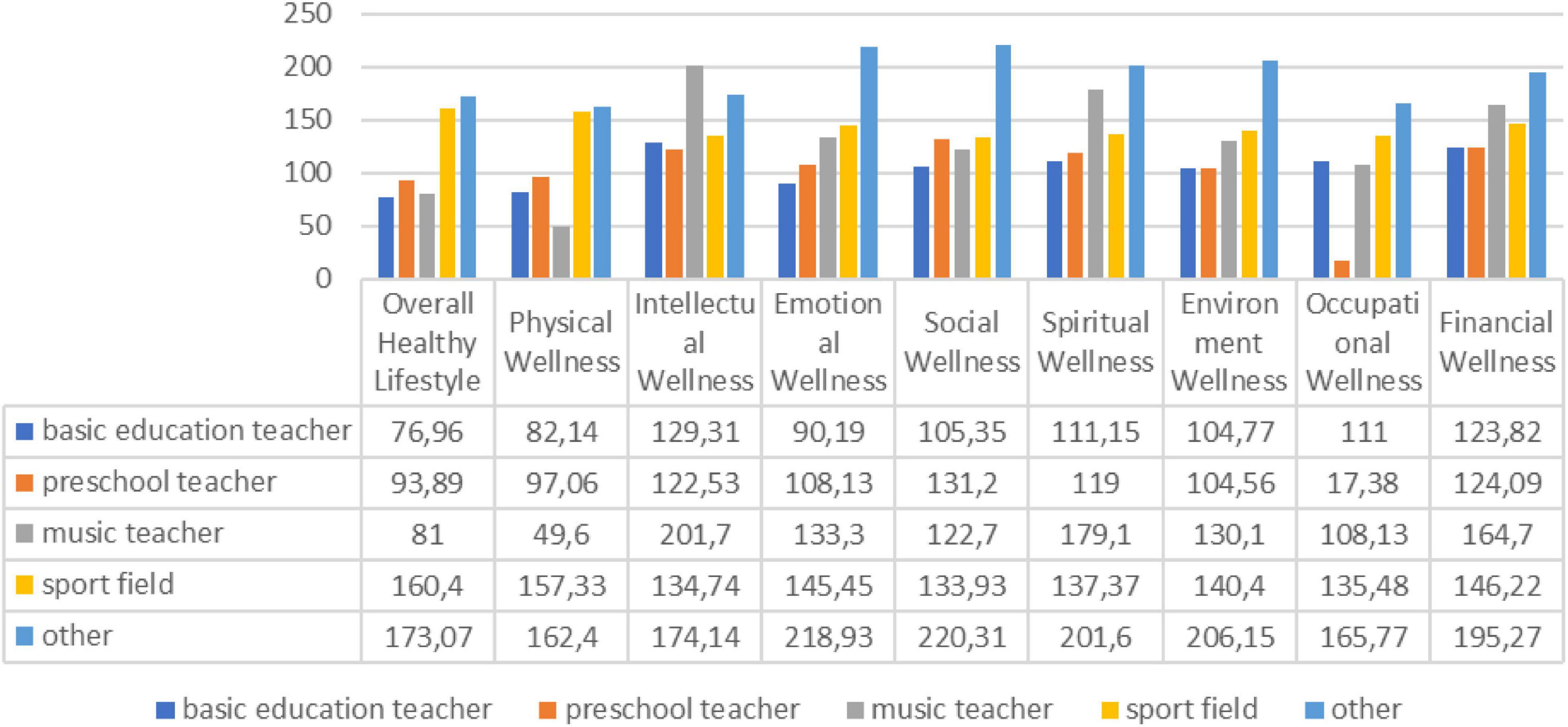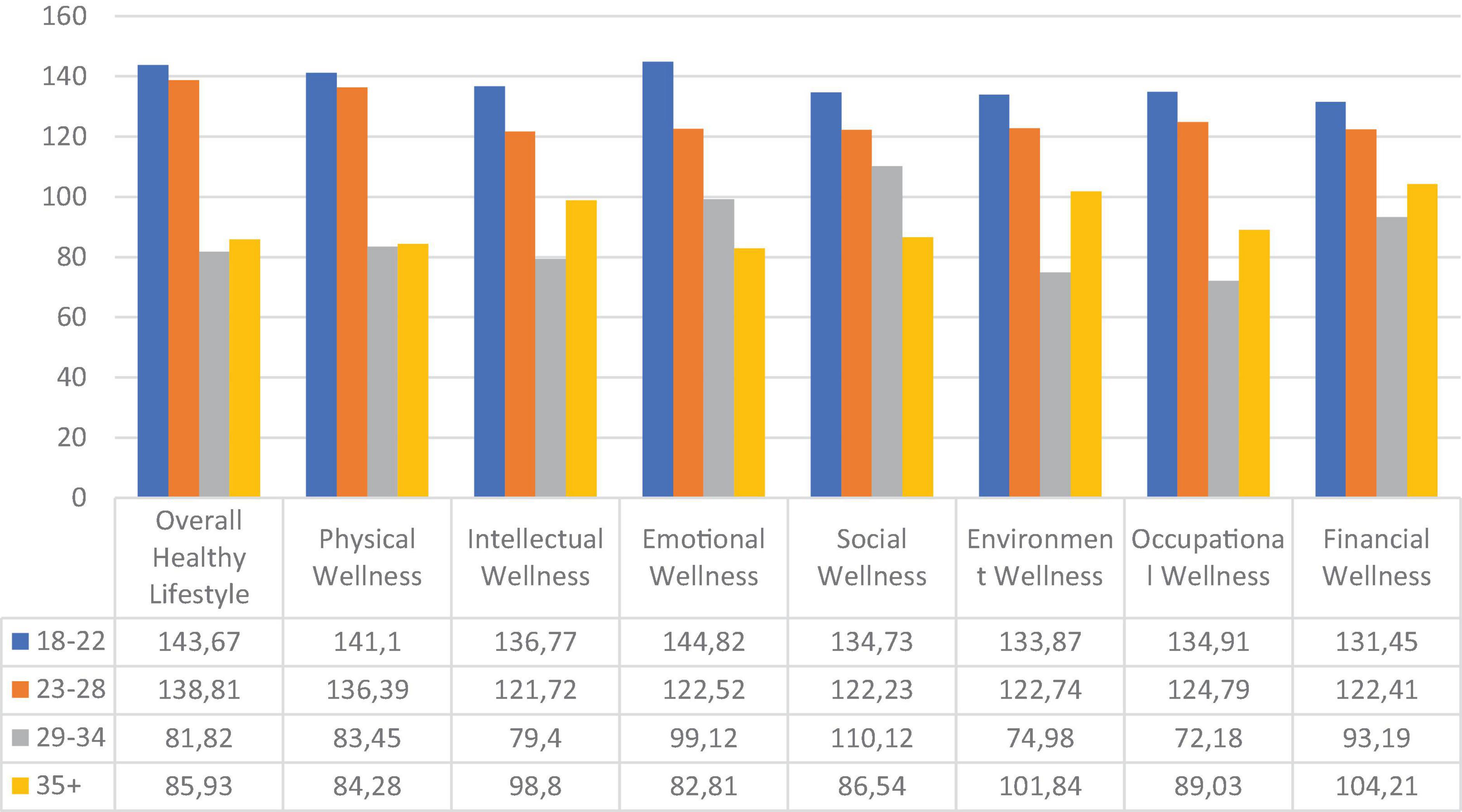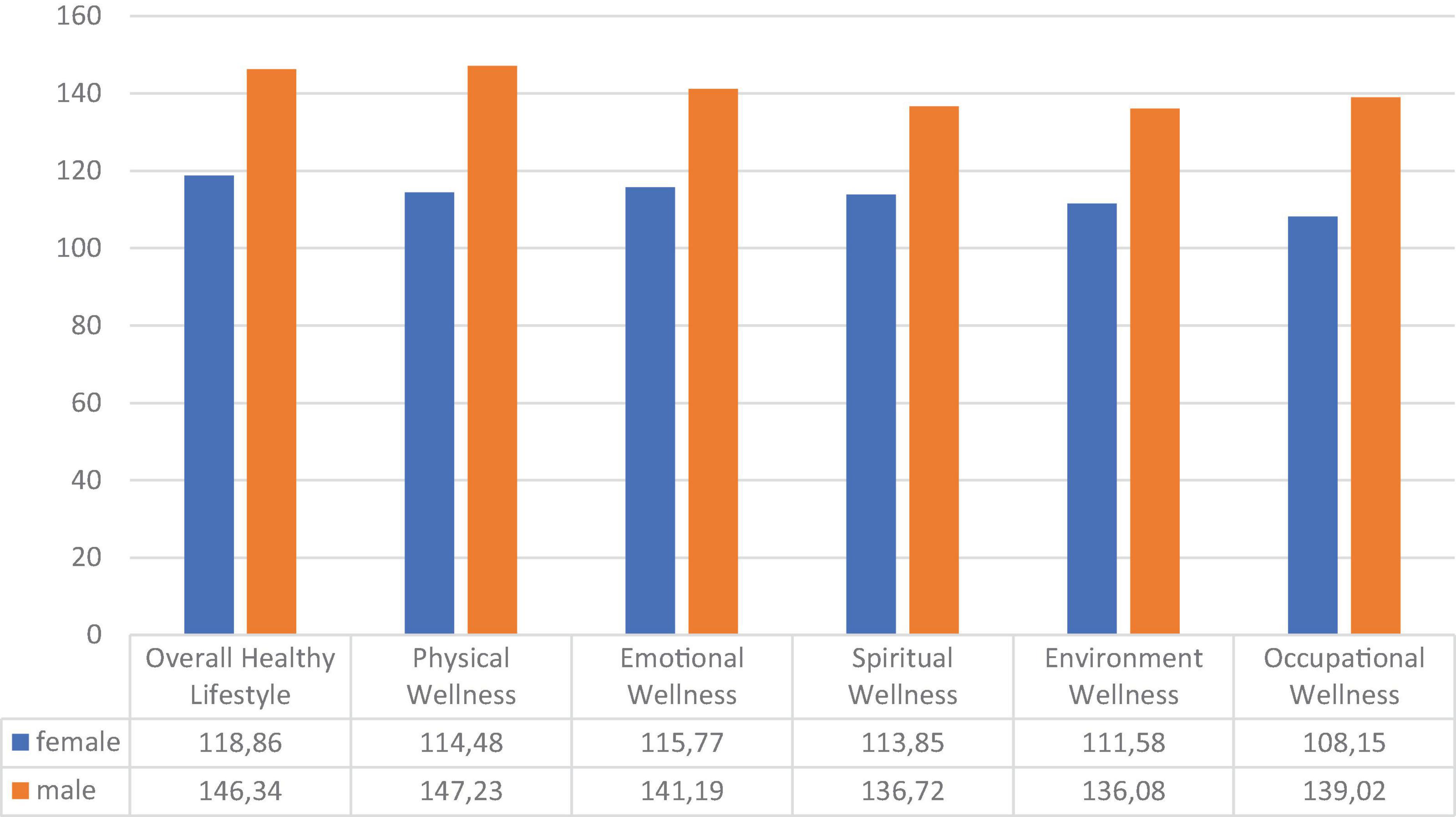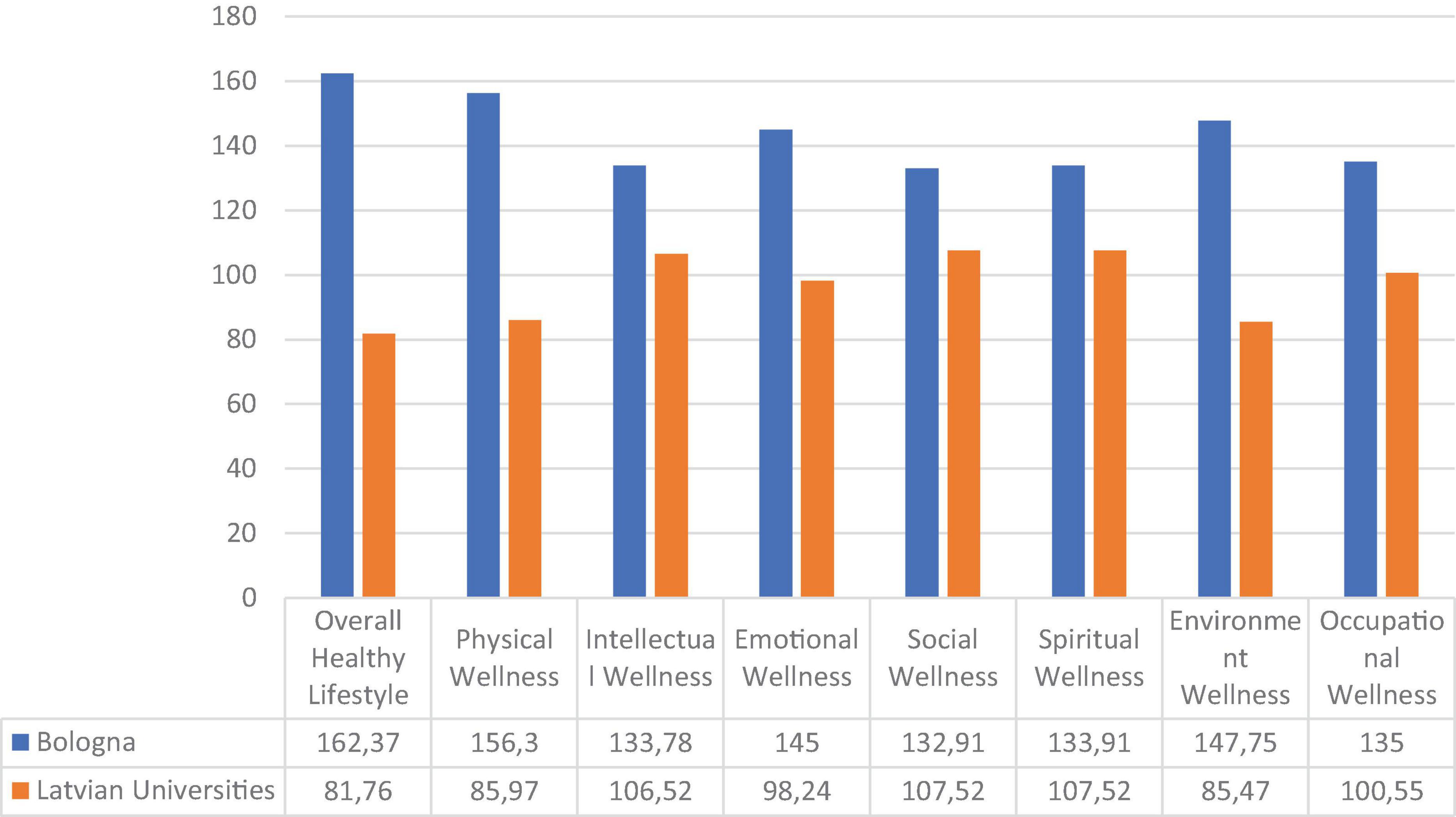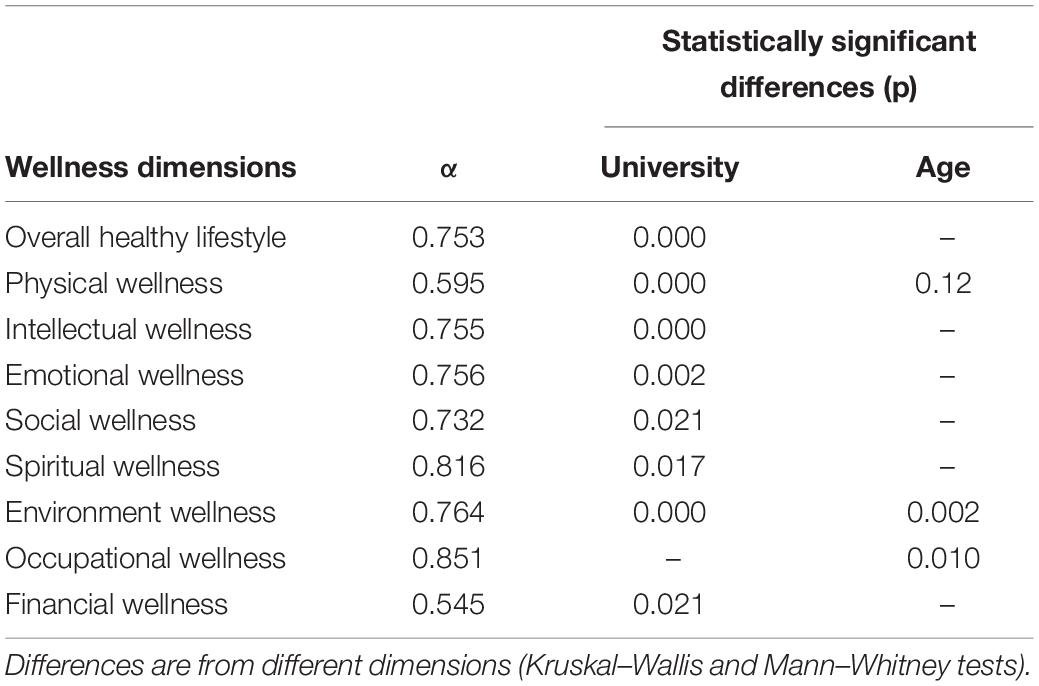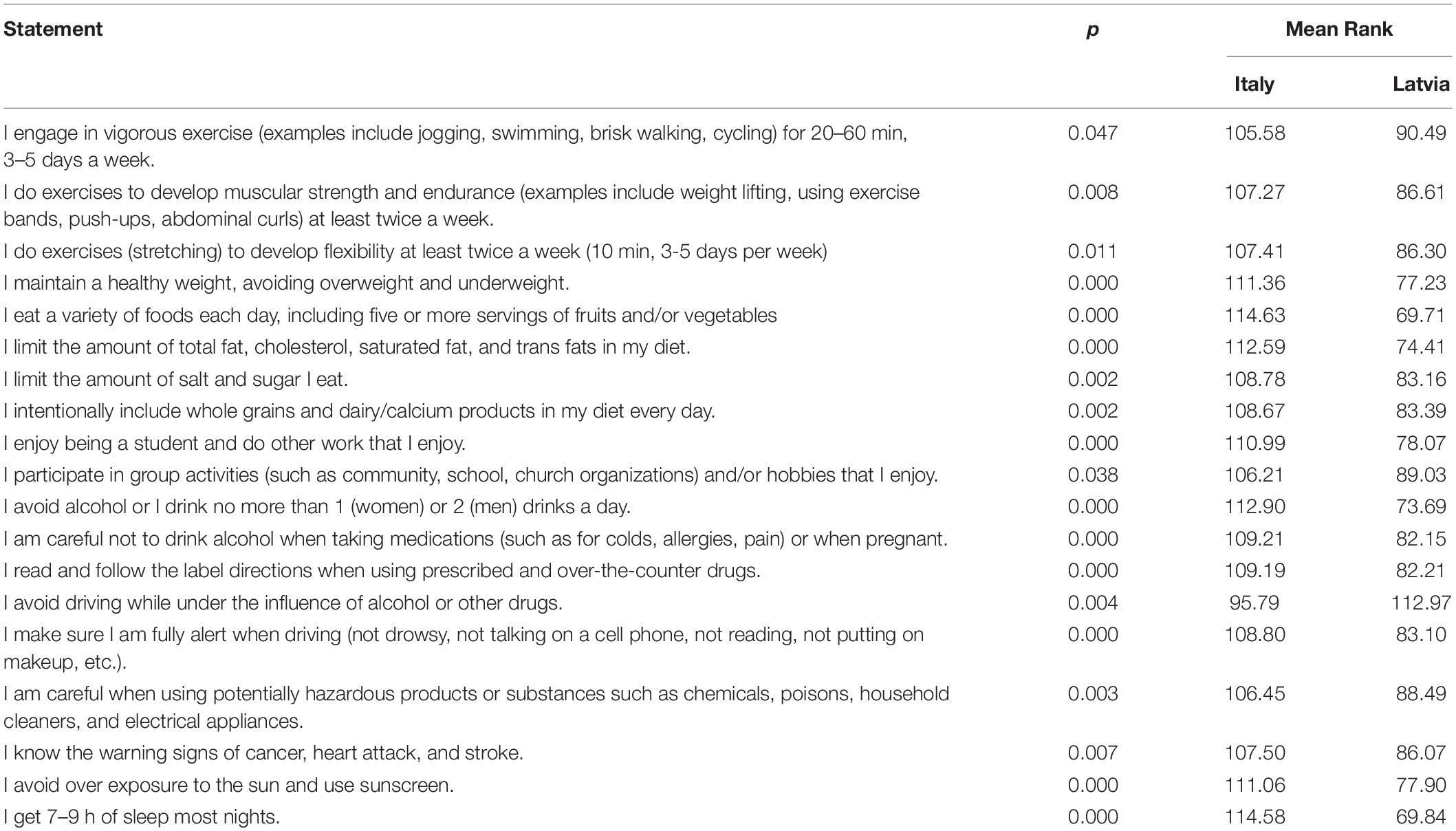- 1Department for Quality of Life Studies, University of Bologna, Bologna, Italy
- 2International College of Football, Tongji University, Shanghai, China
- 3Faculty of Pedagogy and Social Work, Liepaja University, Liepāja, Latvia
- 4Faculty of Education, Languages and Design, Rezekne Academy of Technologies, Rēzekne, Latvia
This study compares lifestyles behavior in Italian and Latvian university students, with special reference to sport students, to assess if there are differences for sex, age, university, or studies specialties. An online questionnaire investigating healthy lifestyle habits and 8 wellness dimensions has been compiled by 156 students (43.6% females) from Italy and 105 from Latvia (82.9% females). Answers were collected between April and December 2020. Presence of smokers in our sample is negligible. The questionnaire showed a good internal consistency (Cronbach α = 0.929). On the total group, statistically significant differences were found in all the dimensions regarding age, sex, study specialty and university. Physical activity was associated with healthier lifestyles choices. Geographical differences were found (eating and sleep behaviors, alcohol awareness) as well as socio-economic differences. Female students shown to be more stressed than males. Occupational wellness increased by age. Sport students shown more health awareness. Many of the differences found between males and females in the total group disappeared when comparing only sport students of the two universities.
Introduction
Quality of life of university students is a major concern for public health, and has been studied extensively, referring to mental health (Auerbach et al., 2016; Sheldon et al., 2021), physical activity and nutrition (Hervás et al., 2018; Sheldon et al., 2021), health related lifestyles such as alcohol, drug abuse and sleep habits (Hervás et al., 2018; Plotnikoff et al., 2019). Self-perception of healthy lifestyles determinants of university students have been studied less (Yahia et al., 2016; Aceijas et al., 2017; Reshetnikov et al., 2018). The findings of these studies are linked to the specificity of the social environment and the interpretation of the results, which is influenced by the cultural context, for example religion (Almutairi et al., 2018). Also, family conditions and social participation (friendships) had been associated to healthy lifestyles choices (Çalışkan et al., 2017). There is an evidence that lifestyles, acquired during youth years, continue to persist even in adulthood (Hultgren et al., 2019), thus making it important to know how these lifestyles develop. The University’s life brings to major changes in lifestyles, including less parental control and increased individual autonomy. New environments also bring stress and the new freedom is sometimes associated with higher alcohol and tobacco consumption, less physical activity, and low consumption of fruit and vegetables (Dodd et al., 2010; Assaf et al., 2019; Hultgren et al., 2019). Socio - economic factors have been hypothesized to be the determinant of certain lifestyles choices (Campos-Matos et al., 2016) and is also known that geographical location influences the mood and thus life habits, sleeping and eating (Wirz-Justice, 2018). Sex also influences lifestyles perceptions, as shown in a Swedish study of university’s students. Males reported to be less stressed and their health, fitness level and mental health were rated higher than for females (Schmidt, 2012) and some study shows how self-rated health can be predicted by sex and ethnicity (Sáez et al., 2020). Another study of Spanish university’s students (Andrés-Villas et al., 2020), found similar results for sex, showing that a significantly greater proportion of men perceived their health as excellent when compared to women, and that men were more involved in sports, both actively than passively. The cohort analyzed in this study, however, does not include sport students. A large multicentric study performed in six countries (students of health professions), shows a good self-perception of health in females but also a higher stress perception. In this study, female’s self-rated health perception was slightly higher than for males: females ate breakfast more frequently, reported higher levels of physical activity and spent more time studying (Cena et al., 2021). The female students of a Greek university, showed higher scores for healthy eating, had a lower rate of overweight/obesity and a lower rate of alcohol consumption (Tirodimos et al., 2009) in comparison to males. Better behaviors in female students with regards to alcohol consumption was observed also in a general cohort of students (with a prevalence of nursing students in the sample) from Sweden, which also tended to be more stressed than males. In this study, males were found to be more at risk of overweight/obesity and less interested in nutrition advice (Bothmer and Fridlund, 2005). The field of study seems to be another factor which influences the lifestyles. A study performed in health, education and other disciplines in Spain, reveals that students enrolled in education (34% of the sample) and other disciplines show a prevalence of tobacco consumption compared to health students (41 vs. 22%). The high percentage of smokers (22%) in health care professions found in this study is quite surprising and has not been observed in other countries (Varela-Mato et al., 2012), where health care students were researched. Health students also showed higher consideration of physical activity (Bothmer and Fridlund, 2005).
A study investigating a sample like ours for geographical distribution, shows that sport students seem more aware of their health status (López-Sánchez et al., 2019) and they take care of their health. Polish (northern) students consume more vegetables and liquids, while Spanish consume more seafood, more dairy products, less alcohol and less tobacco (López-Sánchez et al., 2019). Nutritional habits have found to be associated with sleep (Papaconstantinou et al., 2020) and being a poor sleeper results in an increased consumption of calories (Papaconstantinou et al., 2020).
Interestingly, it seems that poor sleep of medical students was observed in different countries: 40.60% of Iranian students reported poor quality of sleep (Ghoreishi and Aghajani, 2008) while 69% of Lithuanian medical students reported good to excellent nocturnal sleep (Preišegolavičiūtė et al., 2010). The 70% of Hong Kong students of medicine reported sleep deprivation (Huen et al., 2007), 47.1% of medical students in India reported refreshing sleep (Giri et al., 2013), and 31.5% of medical students suffered from sleep deprivation according to a study conducted in Nepal (Khadka et al., 2019).
Physical activity of university students has been largely investigated in scientific literature (Yahia et al., 2016; Aceijas et al., 2017; Hervás et al., 2018; López-Sánchez et al., 2019; Andrés-Villas et al., 2020; Carballo-Fazanes et al., 2020; Papaconstantinou et al., 2020) also comparing different geographical provinces (López-Sánchez et al., 2019). Significant associations were established between physical inactivity and the time exposed to screens, time studying, feeling low, smoking, and anxiety (Proença et al., 2020; Zubiaur et al., 2021). It must be noted that physical activity patterns are also influenced by the socio-cultural context, for example a study performed in the United Arab Emirates, showed a marked difference in male and female students about physical activity (Doyle et al., 2019).
Environmental and meteorological conditions, also influence the patterns of physical activity, for example, a study in Norway shows a relationship of the level of physical activity and depressive symptoms in university students (Kleppang et al., 2018).
Considering ethnicity, Afro-American students have a poor perception of exercising for health and mental health benefits and of having good nutritional habits for healthy living (Barnett et al., 2019). In a large study performed with north American students (with a low percent of Afro-American students among respondents), males reported higher intake of fruits and vegetables, higher physical activity levels, lower stress levels, and poorer sleep quality than females. In this study, sex was found to be related to general lifestyle behaviors, and this finding strengthen the results reported in the previous literature (Olfert et al., 2019). One motivation for our study is that there are very few studies comparing a northern country with a southern country, different for geographical/environmental and socio-economic characteristics (López-Sánchez et al., 2019).
This study aims at investigating the lifestyles behaviors of two universities population, to assess (hypotheses): a) if there are differences in lifestyles behavior according to age and sex; b) if there are differences between students enrolled in different specialties, c) if there are differences according to geographical location of the students (e.g., North and South Europe). Further research was conducted with sport students, hypothesizing that there were less differences between the sex in lifestyle behaviors in sport students compared to non-sport group, thus a subgroups comparison among Italian and Latvian sport students was also performed. Our objectives were thus to examine if the age and sex of participants has an influence on their lifestyles, if the courses which the students attend are in some way associated with their lifestyles, and if the geographical location can affect is some ways the student’s lifestyles.
Materials and Methods
The students participating in this research come from two different universities: one belonging to south Europe (Bologna), the other to north Europe (Liepaja). Bologna city (geographical coordinates:44°29′38′′N 11°20′34′′E) is a middle size north Italian university town of 395.000 habitants with a student population of 70.000. Liepaja is a middle size university town of Latvia (geographical coordinates: 56°30′42′′N 21°00′50′′E) of 80,000 habitants with a student population of 1400. Environmental mean temperature (8.2°Celsius Latvia vs. 14.3° Italy) and economic (pro-capita income 29.901$ Latvia vs. 39.637$ Italy) conditions are quite different between the two countries.
Recruiting of respondents was done by word-of-mouth, email messages, on internet social networks, and during lessons. In Latvia, due to the smaller numbers, the recruiting was made directly during lessons. In addition, a total of 1600 emails were sent to a university’s mail list of Bologna University, Bologna and Rimini Campus, to sport students. All the students were natives of their countries. The students compiled an online questionnaire, previously validated (Robbins et al., 2011). The questionnaire was submitted in English because all the students had good knowledge of English, and possess a European Union standard B1 certificate of proficiency. Due that cultural barrier could be present, the questionnaire was accompanied by an explanation, and we encouraged the students to ask questions if some doubts arised. The questionnaire was previously validated [36] using confirmatory factor analysis. The questionnaire was anonymous, and both Ethical Committees of Liepaja and Bologna University approved the study protocol. Informed consent was requested from the participants prior to the survey. The questionnaire aimed at investigating the Overall Healthy Lifestyle and 8 wellness dimensions: Physical, Intellectual, Emotional, Social, Spiritual, Environmental, Occupational, Financial.
Each dimension is assessed by 10 items. Each item can be answered on a 3-grade scale: Almost always = 4 points; Sometimes/occasionally = 2 points; Very seldom = 1 point. Answers were collected between April and December 2020. This period was in the beginning of COVID-19 pandemic, and this fact could have impacted the responses. However, we do not have any previous data to assess this hypothesis. The recruiting in Latvia were made in the classrooms, because at that time Latvia was at the beginning of pandemic and there were no restrictions on classroom teaching yet. Thus, the results can be useful for a further study to compare the data with post-COVID-19 conditions.
Statistical analysis was performed with SPSS v.25. At first, Cronbach’s alpha test was performed to determine the internal consistency of the survey which gave α = 0.929. The answers were assessed for normality with the Kolmogorov–Smirnov (p < 0.05), which suggested using the non-parametric tests. Then, Kruskal–Wallis and Mann–Whitney tests were performed. The first comparison was performed between universities (country), sex, age and study programmes in the whole sample of students, then a comparison between Italian and Latvian students was performed on the same variables, but only for sport students.
Results
Whole University Populations
In the whole sample, 156 (43.6% females) respondents were from Italy (all having Italian nationality) and 105 from Latvia (82.9% females, all having Latvian nationality). The female percent was higher for Latvian students. This difference can be explained by the high female percentage in the Latvia population, compared to Italy (84.8 males/100 females in Latvia vs 94.6 in Italy) and with a presence of primary school teachers in the Liepaja sample.
Respondents to the questionnaire were 10% of the sent emails. The students belong to different study programmes (Table 1). Smokers% in the sample was negligible (12.2%, 2.8 for Italians and 11.4% for Latvian), and Latvian students have a higher% of smokers.
Sports students form the highest percentage in the sample of respondents, followed by the students of pedagogy, while other students are from different disciplines: arts, mathematics, literature, engineering, history. Italian students were all from the School of Motor Sciences, where Latvian from the Faculty of Pedagogy and Social Work.
Age of the students is reported in Table 2.
Distribution of age shows that a significant% of the sample is over 30. This can be explained with the situation, that both full-time and part-time students are involved in the survey, as well as they come from different study programmes. One respondent (0.4%) did not indicate the age.
Using the Kruskal–Wallis and Mann–Whitney test, it was determined whether there are statistically significant differences in the evaluations according to the respondents profile. Results are summarized in Table 3.
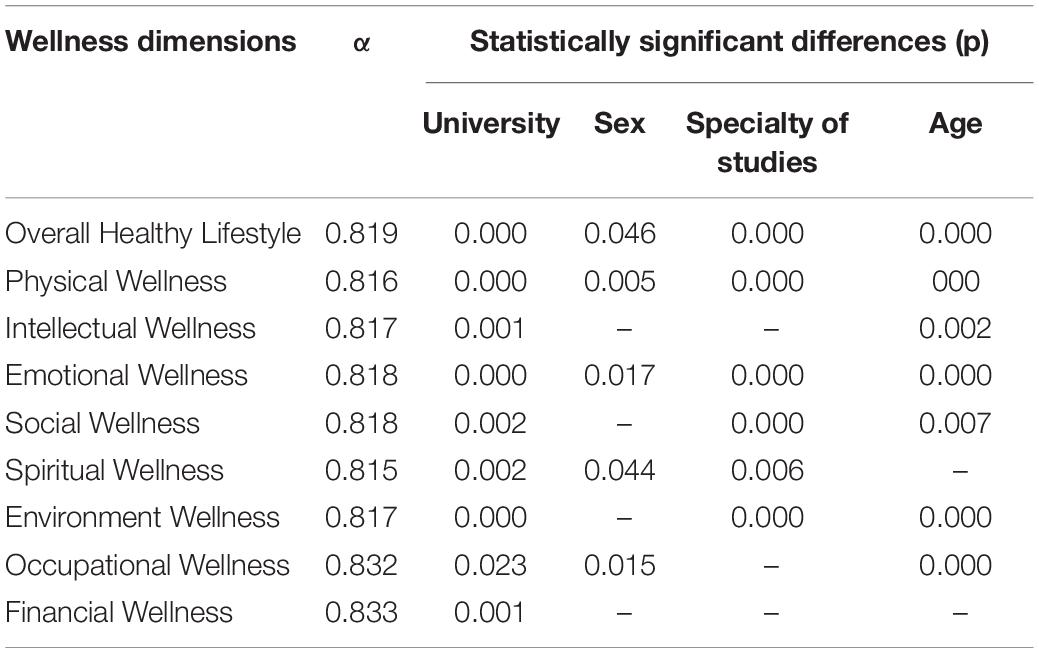
Table 3. Wellness dimensions and statistically significant differences between university, sex, age, and specialty of studies.
The research data, summarized in Table 3, point at statistically significant differences between Universities in all Wellness dimensions, but statistically significant differences with regard to sex are not observed in Intellectual Wellness, Social Wellness, Environmental and Financial Wellness dimensions. Depending on the chosen field of studies, statistically significant differences are not detected in three Wellness dimensions: Intellectual Wellness, Occupational Wellness, and Financial Wellness. Statistically significant differences in relation to age are not observed in two Wellness dimensions - Spiritual Wellness and Financial Wellness.
Several statistically significant differences were found between respondent’s specialty of study (Figure 1).
Interestingly, the highest rate of Overall Healthy Lifestyle is for students whose specialty is marked as “Other” (Mean rank 173.07), the second highest indicator is for students in the field of Sports (Mean Rank 160.4), but the lowest indicator is for students of the Primary Education Teacher programme (Mean Rank 76.96).
Similar results are also found in Physical Wellness dimension for “Other” students (Mean rank 162.4) and Sports students (Mean Rank 175.33), but the lowest indicator is for students of Music Teacher programme (Mean Rank 49.6). The highest indicator of emotional well-being is for “Other” students (Mean Rank 281.93), the second highest score is for students in the field of Sports (Mean rank 145.5), but the lowest – for students majoring in Primary Education Teacher programme (Mean Rank 90.19).
In Social Wellness dimension, the highest indicator is for “Other” students (Mean Rank 220.31), the second highest indicator is for Sports students (Mean rank 133.93) and the lowest indicator is for students specializing in teaching (Mean Rank 105.35).
Spiritual Wellness dimension also shows high scores for “Other” students (Mean Rank 201.6), the second highest score is among Music Teacher students (Mean Rank 179.1), but the lowest score is among Primary Education Teacher students (Mean Rank 111.15).
In the Environment Wellness dimension, the highest results were shown by “Other” students (Mean Rank 206.15), the second highest - by Sports students (Mean rank 140.4), but the lowest results were obtained from Pre-school and Primary Education students. Statistically significant differences have not been found between the specialties chosen by students in three Wellness dimensions - Intellectual Wellness, Occupational Wellness, and Financial Wellness, therefore they are not commented in more detail.
The persistently high scores are for sports students, it can be explained with the specifics of the field, as well as other research data [20; 21] indicate higher physical activity, better eating habits and well-being of sports students. “Other” specialties, such as computer science, new media and linguistics, have a small number of respondents (5.1%), therefore the sample of students from other specialties should be extended in order to obtain more accurate data.
Ranks by Age
Several statistically significant differences were found according to the respondent’s age (see Mean Rank in Figure 2).
All results of Wellness dimensions decline with age with some exception for the +35 group. The older age group is explained with the presence of part-time students. Results for Intellectual, Environmental and Occupational Wellness dimensions increase in the age group + 35, and statistically significant differences with regards to age are not observed in two Wellness dimensions - Spiritual Wellness and Financial Wellness. This result can be explained by the fact that the older respondents have a job and can afford better life conditions.
Results for sex differences are reported as Mean Rank in Figure 3.
Results for sex differences are reported as Mean Rank in Figure 3. Results for male students are higher in Overall Healthy Lifestyle, Physical and Emotional Wellness dimensions, and it must be taken into account that statistically reliable differences between the sexes are not detected in dimensions of Intellectual Wellness, Social Wellness, Environment Wellness and Financial Wellness. The results of other similar research studies are contradictory: some studies show that male representatives score higher in Overall Healthy Lifestyle and Wellness dimensions, suggesting the need for improvement of conditions for female students in the universities (Aceijas et al., 2017; Almutairi et al., 2018; Assaf et al., 2019), which possibly is related to cultural traditions of different countries and is linked to lower wages and social status for women; but other research studies show that female students score higher in Overall Healthy Lifestyle and Wellness dimensions (Bothmer and Fridlund, 2005; Schmidt, 2012; Cena et al., 2021).
In Figure 4, are reported the ranks in the two Universities.
Bologna students score higher in all considered Wellness dimensions in comparison to Latvian students (see Figure 4). One of the reasons for that is the fact that Bologna University students mostly represent the field of Sports, but Latvian (Liepaja University) students represent different Teacher Education specialties and there are fewer Sports students, as well as these results probably reflect the different socio-economic and geographic environment, and they are in accord with the results of a previous study comparing a Northern Europe and a Southern Europe cohort of students (López-Sánchez et al., 2019).
Comparison of Latvian and Italian Sport Students
In the second part of this research, the comparison is made between Sports students from Bologna University and Liepaja University/. There were 140 respondents from Sports programmes of Bologna University (in total there are 1000 sports students) and 61 from Latvia The age of respondents - mostly 18–28 years old as reported in Table 4. Latvian students are older, because Latvian respondents are also part-time sports students. In Italian group, there are 56 female (40%) and 84 male (60%) respondents, but in Latvian group - 34 female (55.7%) and 27 male (44.3%) respondents.
Cronbach’s alpha test was performed to determine the internal consistency of the survey which gave an α = 0.926.
In Table 5, significant differences by country/university and Cronbach’s alpha for each dimension are reported for sport students.
Statistically significant differences were found according to the respondent’s University except for Occupational Wellness and a few differences with regards to age.
Differences in the Overall Healthy Lifestyle are presented in Table 6.
Overall, the Italian sports students are more aware of their food choices. Alcohol and drugs awareness is higher in Latvian Students. Higher consumption of fruit in Italian students is probably linked to the geographical conditions as well awareness of the risk of sun exposure (Driscoll, 1990). However, differences that can be explained with the geographical location have been evidenced also in other studies, which compared European northern and southern countries (López-Sánchez et al., 2019). Exercise habits show that Italians practice more strength and flexibility exercises than Latvians. Italians also eat more whole grain foods. Also, they are more aware of the risk of eating saturated fat and drinking alcohol and of the importance of sleep and healthy weight to maintain health. These results comply with the previous findings that observed the link between sleep and moderate to intense physical activity in university students (Memon et al., 2021). Diet is also a major concern for Italian students, and it is known that diet is related to stress (Alfreeh et al., 2020), sleep (Da Silva et al., 2020) and overall mental health (Muscaritoli, 2021). Italian students also show higher rankings in social activities. In a comparative study on mental health of German and Chinese students, more regular social rhythm and physical activity was associated with better mental health (Velten et al., 2018). These results can be explained also by a geographical situation of both groups of students, as well as socio-economic differences. Latvian students score higher only in one position related to safety measures: “I avoid driving while under the influence of alcohol or other drugs.”
In Table 7, the statistically significant differences are shown for Intellectual, Emotional, Social, Spiritual, Environmental and Occupation Wellness dimensions, except for Physical Wellness and Financial wellness, where Cronbach’s alpha test (α) rates are lower than 0.7.
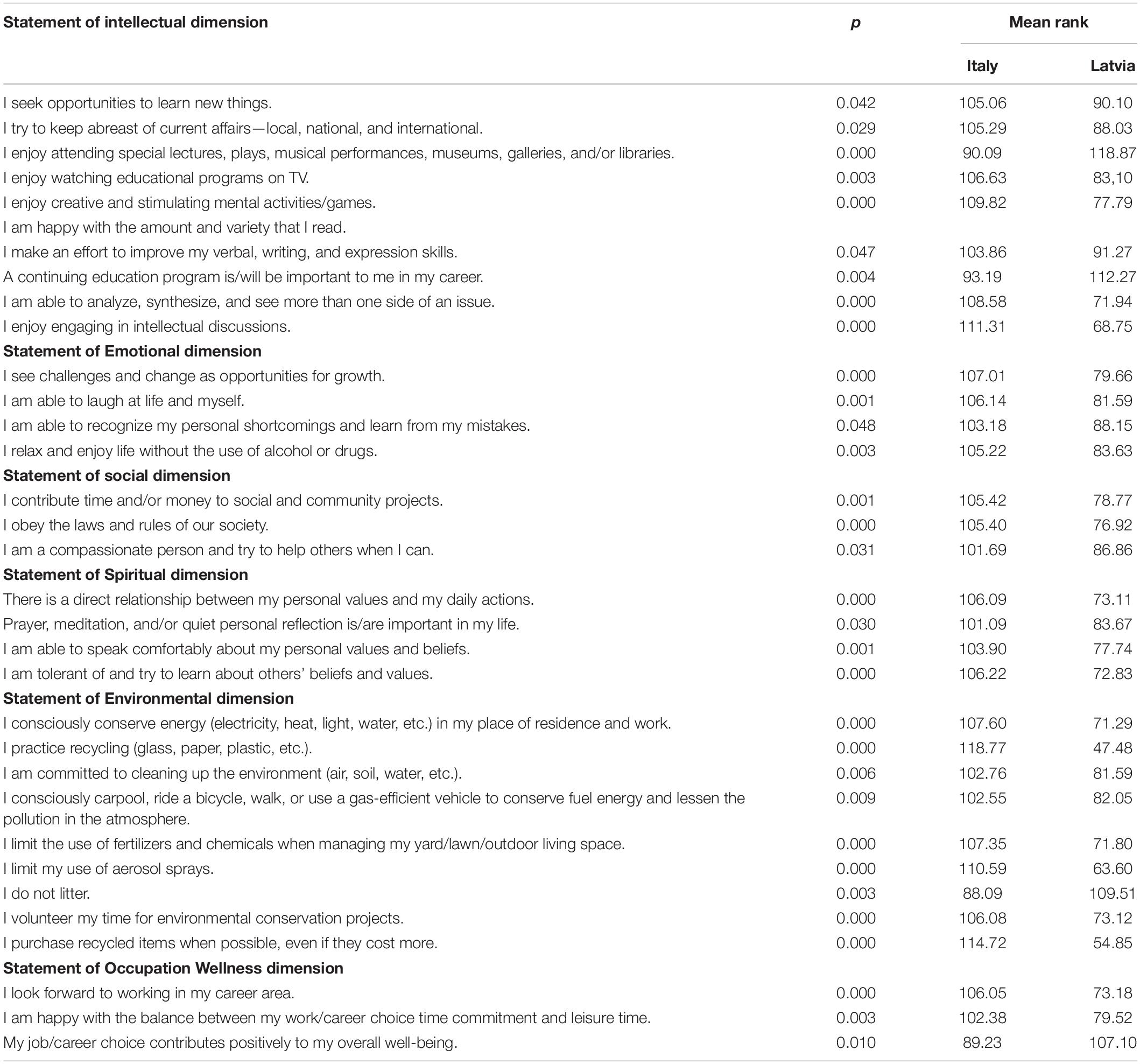
Table 7. Differences between indicators of wellness dimensions for Latvian and Italian sport students.
Italian students show higher rankings at Statement of Intellectual dimension, but the indicators of two positions “I enjoy attending special lectures, plays, musical performances, museums, galleries, and/or libraries” and “A continuing education program is/will be important to me in my career” are higher for Latvian students, which demonstrates the cultural traditions of Latvian students and the peculiarities of the socio-economic situation. Latvian students have higher scores also in two statements that characterize the Environmental Wellness and Occupation Wellness dimensions: “I do not litter” and “My job/career choice contributes positively to my overall well-being,” which can be explained by the above-mentioned differences in students’ cultural traditions. In this study, Italian students show higher rankings in all wellness dimensions.
Our hypothesis was that sport has a leveling effect on gendre differences in sport students. We have not found any significant differences between male and female sport students. A masculinization of sports studies has been observed before (Porto, 2009; Payeras et al., 2019) and attributed to social reasons, e.g., less female culture in sport studies (Payeras et al., 2019). Cultural conducts in the construction and transmission of male sex orientations and practices in the profession has been observed in PE teachers (David Brown and Evans, 2004; Serra et al., 2018). These factors may have influenced the less males/females’ differences found in the sport studies students. Interestingly, females sport students seem to perceive themselves to be more stressful but also to better cope with stress than males. This result is similar to previous findings in Swedish university students (general curriculum), which found the females more stressed than males (Schmidt, 2012). Similar results were found in female medical students (Burger and Scholz, 2018). It is not clear why female sport students are more stressed than males sport students. This issue needs further investigations. A hypothesis can be that the physical load causes more stress in females than in males or can be found in the organization of the university life. A further finding of our study is that sleep seems to decline with age. In respect to our hypotheses, (a) we found differences in lifestyles behaviour according to age and sex; (b) we found differences between students enrolled in different study fields, and (c) we found differences according to geographical location of the students (e.g., North and South Europe).
Conclusion
Overall, substantial (significant) differences were found between males and females, between universities, between ages, and between the study courses in all the dimensions of healthy lifestyles. These differences are reduced in sport studies. We can hypothesize that this is an effect of sport practice, which has a “masculinization” effect, but this hypothesis must be investigated to draw firm conclusions. Environmental factors, as well as socio-demographic factors can explain the differences between Italian and Latvian students. It must be evidenced that especially the differences in infrastructure for sport and study are large between the two countries. Our results shows that geographical latitude seems to influence the eating habits. Despite the growing politics to improve the females’ conditions in the society, there are improvements in the female conditions in the university. It is necessary to empower the female students, which still show worse scores than males in many items. Female students are still facing difficulties relating to their life satisfaction and lifestyles in the university, and this require actions by the administrative bodies of universities. Our study confirm that the overall health perception improves significantly with age, and this can be explained by the better economic conditions. It is evident that sport students are more aware of their health, in comparison to other groups. In our sample, the presence of smokers is negligible, while alcohol seems to be an important health concern, especially in sport students. In respect to our hypotheses (a) we found differences in lifestyles behaviour according to age and sex; (b) we found differences between students enrolled in different study fields, and (c) we found differences according to geographical location of the students (e.g., North and South Europe).
A limit of our study is the low number of respondents from sport’s studies, especially in the Latvian sample, albeit they form a large percent of the respective populations. However, we tested the whole groups of students in these studies fields.
The limitations of our study are that the questionnaires have been compiled on-line, over a relatively long-time span, and no rewarding has been given to participate in the study in order to increase the number of participants. Some data about quantification of economic incomes are missing due to privacy reasons and some answers to sensitive questions (e.g., alcohol and drugs consumption) could have been biased. Also, we did not consider any physiologic parameters, for example heart rate variability at rest who has been shown to be associated with lifestyles, body weight, and stress. These data can be useful to better understand the influence of sport studies on healthy lifestyles and to design intervention programs to improve healthy lifestyle targeted to university students. The result can be useful to reduce the disparities between male and female’ students, and for designing double degree university courses between Latvia and Italy. We can suggest the development of specific information campaigns addressed to reduce the un-healthy lifestyle, by means of investments in better food availability for students, more gyms and in general to improve the financing for student wellbeing inside the university. Further, the study can be useful for a post-pandemic comparison. Future directions can incorporate other measures of physical fitness or nutrition (e.g., physical activity or nutrition questionnaire) and include other study fields of other European and/or non-European universities.
Data Availability Statement
The raw data supporting the conclusions of this article will be made available by the authors, without undue reservation.
Ethics Statement
The studies involving human participants were reviewed and approved by the University of Bologna and Liepaja University Ethical committees. The patients/participants provided their written informed consent to participate in this study.
Author Contributions
AC: ideation and writing. HV: ideation and data collection. SU: data analysis. All authors contributed to the article and approved the submitted version.
Conflict of Interest
The authors declare that the research was conducted in the absence of any commercial or financial relationships that could be construed as a potential conflict of interest.
Publisher’s Note
All claims expressed in this article are solely those of the authors and do not necessarily represent those of their affiliated organizations, or those of the publisher, the editors and the reviewers. Any product that may be evaluated in this article, or claim that may be made by its manufacturer, is not guaranteed or endorsed by the publisher.
References
Aceijas, C., Waldhäusl, S., Lambert, N., Cassar, S., and Bello-Corassa, R. (2017). Determinants of health-related lifestyles among university students. Perspect. Public Health 137, 227–236. doi: 10.1177/1757913916666875
Alfreeh, L., Abulmeaty, M. M. A., Abudawood, M., Aljaser, F., Shivappa, N., Hebert, J. R., et al. (2020). Association between the inflammatory potential of diet and stress among female college students. Nutrients 12:2389. doi: 10.3390/nu12082389
Almutairi, K. M., Alonazi, W. B., Vinluan, J. M., Almigbal, T. H., Batais, M. A., Alodhayani, A. A., et al. (2018). Health promoting lifestyle of university students in Saudi Arabia: a cross-sectional assessment. BMC Public Health 18:1093. doi: 10.1186/s12889-018-5999-z
Andrés-Villas, M., Díaz-Milanés, D., Remesal-Cobreros, R., Vélez-Toral, M., and Pérez-Moreno, P.J. (2020). Dimensions of Leisure and Perceived Health in Young University Students. Int. J. Environ. Res. Public Health 17:8750. doi: 10.3390/ijerph17238750
Assaf, I., Brieteh, F., Tfaily, M., El-Baida, M., Kadry, S., and Balusamy, B. (2019). Students’ university healthy lifestyle practice: quantitative analysis. Health Inf. Sci. Syst. 7:7. doi: 10.1007/s13755-019-0068-2
Auerbach, R. P., Alonso, J., Axinn, W. G., Cuijpers, P., Ebert, D. D., Green, J. G., et al. (2016). Mental disorders among college students in the World Health Organization World Mental Health Surveys. Psychol. Med. 14, 2955–2970. doi: 10.1017/S0033291716001665
Barnett, M., McFarland, A., Miller, J. W., Lowe, V., and Hatcher, S. S. (2019). Physical and mental health experiences among African American College Students. Soc. Work Public Health 34, 145–157. doi: 10.1080/19371918.2019.1575308
Bothmer, M. I. K. V., and Fridlund, B. (2005). Sex differences in health habits and in motivation for a healthy lifestyle among Swedish university students. Nurs. Health Sci. 7, 107–118. 00227.x doi: 10.1111/j.1442-2018.2005
Burger, P. H. M., and Scholz, M. (2018). Sex as an underestimated factor in mental health of medical students. Ann. Anat. 218, 1–6. doi: 10.1016/j.aanat.2018.02.005
Çalışkan, C., Arberk, K., and Üner, S. (2017). Healthy Lifestyle Behaviors of University Students. Prehosp. Disaster Med. 32, S213–S213. doi: 10.1017/S1049023X17005544
Campos-Matos, I., Russo, G., and Perelman, J. (2016). Connecting the dots on health inequalities–a systematic review on the social determinants of health in Portugal. Int. J. Equity Health 16, 15–26. doi: 10.1186/s12939-016-0314-z
Carballo-Fazanes, A., Rico-Díaz, J., Barcala-Furelos, R., Rey, E., Rodríguez-Fernández, J. E., Varela-Casal, C., et al. (2020). Physical activity habits and determinants, sedentary behaviour and lifestyle in university students. Int. J. Environ. Res. Public Health. 17:3272. doi: 10.3390/ijerph17093272
Cena, H., Porri, D., De Giuseppe, R., Kalmpourtzidou, A., Salvatore, F. P., El Ghoch, M., et al. (2021). How healthy are health-related behaviors in University Students: the HOLISTIC study. Nutrients 13:675. doi: 10.3390/nu13020675
Da Silva, R., Barbosa, M. L., Rodrigues, B., Da Silva, C. C. N., and Moura, A. A. (2020). Association between the degree of processing of consumed foods, and sleep quality in adolescents. Nutrients 12:462. doi: 10.3390/nu12020462
David Brown, D., and Evans, J. (2004). Reproducing Sex? Intergenerational links and the male PE teacher as a cultural conduit in teaching physical education. J. Teach. Phys. Educ. 23, 48–70. doi: 10.1123/jtpe.23.1.48
Dodd, L. J., Al-Nakeeb, Y., Nevill, A. M., and Forshaw, M. J. (2010). Lifestyle risk factors of students: a cluster analytical approach. Prev. Med. 51, 73–77. doi: 10.1016/j.ypmed.2010.04.005
Doyle, C. B., Khan, A., and Burton, N. W. (2019). Recreational physical activity context and type preferences among male and female Emirati university students. Int. Health 11507–11512. doi: 10.1093/inthealth/ihz002
Driscoll, D. M. (1990). A perspective on weather-human response relationships. Int. J. Environ. Stud. 36, 19–25. doi: 10.1080/00207239008710580
Ghoreishi, A., and Aghajani, A. H. (2008). Sleep quality in Zanjan university medical students. Tehran Univ. Med. J. 66, 61–67. doi: 10.1007/s11325-020-02189-9
Giri, P., Baviskar, M., and Phalke, D. (2013). Study of sleep habits and sleep problems among medical students of pravara institute of medical sciences Loni, Western Maharashtra, India. Ann. Med. Health Sci. Res. 3, 51–54. doi: 10.4103/2141-9248.109488
Hervás, G., Ruiz-Litago, F., Irazusta, J., Fernández-Atutxa, A., Fraile-Bermúdez, A. B., and Zarrazquin, I. (2018). Physical activity, physical fitness, body composition, and nutrition are associated with bone status in University Students. Nutrients 10:61. doi: 10.3390/nu10010061
Huen, L. E., Chan, T.-W. G., Yu, W.-M. M., and Wing, Y.-K. (2007). Do medical students in Hong Kong have enough sleep? Sleep Biol. Rhythms 5, 226–230.
Hultgren, B. A., Turrisi, R., Cleveland, M. J., Mallett, K. A., Reavy, R., Larimer, M. E., et al. (2019). Transitions in drinking behaviors across the college years: a latent transition analysis. Addict. Behav. 92, 108–114. doi: 10.1016/j.addbeh.2018.12.021
Khadka, R., Bista, S., Baskota, S., Poudel, L., and Gurung, M. (2019). Sleep Quality among College Students in Kathmandu Valley, Nepal. Nepal Med. J. 2, 1–4.
Kleppang, A. L., Hartz, I., Thurston, M., and Hagquist, C. (2018). The association between physical activity and symptoms of depression in different contexts - a cross-sectional study of Norwegian adolescents. BMC Public Health 18:1368. doi: 10.1186/s12889-018-6257-0
López-Sánchez, G. F., Radzimiński, Ł., Skalska, M., Jastrzębska, J., Smith, L., Wakuluk, D., et al. (2019). Body composition, physical fitness, physical activity and nutrition in polish and spanish male students of sports sciences: differences and correlations. Int. J. Environ. Res. Public Health 16:1148. doi: 10.3390/ijerph16071148
Memon, A. R., Gupta, C. C., Crowther, M. E., Ferguson, S. A., Tuckwell, G. A., and Vincent, G. E. (2021). Sleep, and physical activity in university students: a systematic review and meta-analysis. Sleep Med. Rev. 20:101482. doi: 10.1016/j.smrv.2021.101482
Muscaritoli, M. (2021). The impact of nutrients on mental health and well-being: insights from the literature. Front. Nutr. 8:656290. doi: 10.3389/fnut.2021.656290
Olfert, M. D., Barr, M. L., Charlier, C. C., Greene, G. W., Zhou, W., and Colby, S. E. (2019). Sex differences in lifestyle behaviors among U.S. College Freshmen. Int. J. Environ. Res. Public Health 16:482. doi: 10.3390/ijerph16030482
Papaconstantinou, E., Quick, V., Vogel, E., Coffey, S., Miller, A., and Zitzelsberger, H. (2020). exploring relationships of sleep duration with eating and physical activity behaviors among Canadian University Students. Clocks Sleep 2, 194–207. doi: 10.3390/clockssleep2020016
Payeras, P. S., Prat, S. S., Soler, A. V., and Hinojosa-Alcalde, I. (2019). Masculinization in physical activity and sport sciences degree programs. Apunts: Educ. Fís. Esports 135, 9–25. doi: 10.2519/jospt.2008.2386
Plotnikoff, R. C., Costigan, S. A., Kennedy, S. G., Robards, S. L., Germov, J., and Wild, C. (2019). Efficacy of interventions targeting alcohol, drug and smoking behaviors in university and college students: a review of randomized controlled trials. J. Am. Coll. Health 67, 68–84. doi: 10.1080/07448481.2018.1462821
Porto, B. (2009). Feminización y masculinización en los estudios de maestro y educación física en Galicia. Rev. Invest. Educ. 6, 50–57.
Preišegolavičiūtė, E., Leskauskas, D., and Adomaitienė, V. (2010). Associations of quality of sleep with lifestyle factors and profile of studies among Lithuanian students. Medicina 46, 482–489.
Proença, M., Furlanetto, K. C., Morita, A. A., Bisca, G. W., Mantoani, L. C., and Pitta, F. (2020). Profile and determinants of daily physical activity objectively assessed in university students. J. Sports Med. Phys. Fitness 60, 1493–1501. doi: 10.23736/S0022-4707.20.11059-4
Reshetnikov, A. V., Prisyajnaya, N. V., Reshetnikov, V. A., and Efimov, I. A. (2018). The features of healthy life-style perception by students of Medical Universities. Probl. Sotsialnoi Gig. Zdravookhranenniiai Istor. Med. 26, 201–206. doi: 10.32687/0869-866X-2018-26-201-20
Robbins, G., Powers, D., and Burgess, S. A. (2011). Wellness Way of Life. Available online at: https://docs.google.com/forms/d/e/1FAIpQLSdjF4CU7KIQZAI5j9C_KrcCwFXh5wmw0Gn-NxtSJ2EjFWhlbg/viewform (accessed April 26, 2021).
Sáez, I., Solabarrieta, J., and Rubio, I. (2020). Physical self-concept, sex, and physical condition of Bizkaia University Students. Int. J. Environ. Res. Public Health. 17:5152. doi: 10.3390/ijerph17145152
Schmidt, M. (2012). Predictors of self-rated health and lifestyle behaviours in Swedish university students. Glob. J. Health Sci. 4, 1–14.. doi: 10.5539/gjhs.v4n4p1
Serra, P., Soler, S., Prat, M., Vizcarra, M. T., Garay, B., and Flintoff, A. (2018). The (in)visibility of sex knowledge in the physical activity and sport science degree in Spain. Sport Educ. Soc. 23, 324–338. doi: 10.1080/13573322.2016.1199016
Sheldon, E., Simmonds-Buckley, M., Bone, C., Mascarenhas, T., Chan, N., Wincott, M., et al. (2021). Prevalence, and risk factors for mental health problems in university undergraduate students: a systematic review with meta-analysis. J. Affect. Disord. 287282–292. doi: 10.1016/j.jad.2021.03.054
Tirodimos, I., Georgouvia, I., Savvala, T. N., Karanika, E., and Noukari, D. (2009). Healthy lifestyle habits among Greek university students: differences by sex and faculty of study. East. Mediterr. Health J. 15ı, 722–728.
Varela-Mato, V., Cancela, J. M., Ayan, C., Martín, V., and Molina, A. (2012). Lifestyle and health among Spanish University students: differences by sex and academic discipline. Int. J. Environ. Res. Public Health 9, 2728–2741. doi: 10.3390/ijerph9082728
Velten, J., Bieda, A., Scholten, S., Wannemüller, A., and Margraf, J. (2018). Lifestyle choices and mental health: a longitudinal survey with German and Chinese students. BMC Public Health 18:632. doi: 10.1186/s12889-018-5526-2
Wirz-Justice, A. (2018). Seasonality in affective disorders. Gen. Comp. Endocrinol. 258, 244–249. doi: 10.1016/j.ygcen.2017.07.010
Yahia, N., Wang, D., Rapley, M., and Dey, R. (2016). Assessment of weight status, dietary habits and beliefs, physical activity, and nutritional knowledge among university students. Perspect. Public Health 136, 231–244. doi: 10.1177/1757913915609945
Keywords: healthy lifestyle, sport studies, wellness, students, university
Citation: Cicchella A, Vecenane H and Usca S (2022) Healthy Lifestyles of University Students, According to Demographics, Nationality, and Study Specialty With Special Reference to Sport Studies. Front. Educ. 7:889603. doi: 10.3389/feduc.2022.889603
Received: 04 March 2022; Accepted: 16 May 2022;
Published: 09 June 2022.
Edited by:
Satu Perälä-Littunen, University of Jyväskylä, FinlandReviewed by:
Sopa Sabin, Lucian Blaga University of Sibiu, RomaniaMarco Batista, Instituto Politécnico de Castelo Branco, Portugal
Gülcan Demir, Sinop University, Turkey
Copyright © 2022 Cicchella, Vecenane and Usca. This is an open-access article distributed under the terms of the Creative Commons Attribution License (CC BY). The use, distribution or reproduction in other forums is permitted, provided the original author(s) and the copyright owner(s) are credited and that the original publication in this journal is cited, in accordance with accepted academic practice. No use, distribution or reproduction is permitted which does not comply with these terms.
*Correspondence: Antonio Cicchella, YW50b25pby5jaWNjaGVsbGFAdW5pYm8uaXQ=
 Antonio Cicchella
Antonio Cicchella Helena Vecenane
Helena Vecenane Svetlana Usca
Svetlana Usca

